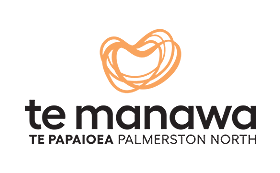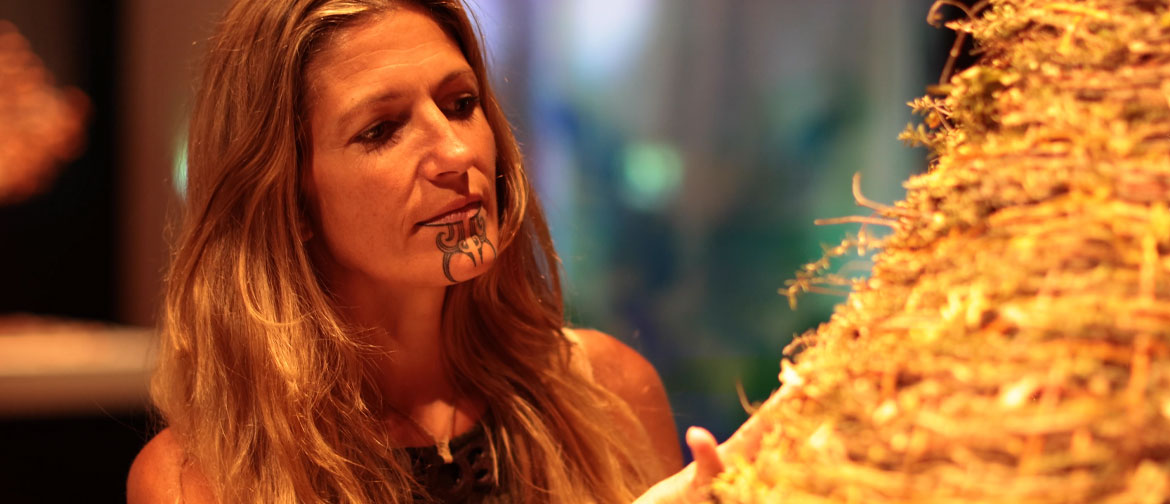Keli: The most intricate part is probably the stitching of the collected doilies, stitching them so they would blend but also flow in with the paintings that I’ve chosen to put on the outside. At first the idea was to have more imagery; I had a test panel that I was having a play with, and it worked out so that when you were inside it would look like they were shadows. However when I started painting onto the fabric, the same effect wasn’t happening so I just continued with how it was working.
It is quite hard to paint with earth-based pigments. They’re not going to stay the same as paint, they don’t absorb the same. So I’ve had to let the materials do what they were going to do, which is a nice way to work, actually, because you’re working with the material, almost together.
Karen: Which is a big part of your practice, isn’t it: working with materiality and earth-based elements like the weaving and the pigments and your clay. It tends to be part of the way you operate as an eco-therapist and the other work that you do.
Keli: All the pigments that I collected for the piece were from places that I visited. It’s pretty much just uku and kōkōwai – clay, really, with water added. I’ve also used water-based pens to do some linework around the edges. When it didn’t appear in the way I first envisioned it, I thought, “OK, we can work with this, if it’s going to look like this I’m going to have to have a play and do something else.” Other than that it was just dyed with plant material. Tanekaha creates that beautiful pinky-brown tone
Te Manawa: What was the overall effect that you set out to achieve?
Keli: I wanted to achieve a safe space to sit and hear stories, and the stories are all on the walls. They’re stories of different atua, or goddesses, or tīpuna, ancestors that have guided me and who I engage with as a daily practice. I didn’t want to personify them into a human, and so I thought, “how do they speak to me? How do I engage with them daily?” I thought of all the ways that I interact in that realm and decided that I would do the imagery of that instead.
I think with my work as well I never really have a plan to start with, I don’t have a set vision in my mind of how I want something to look. I’ll have a feeling about it, I know how I would like it to emerge. I think that’s how I’m a little bit different, maybe, from some of the other artists who work with a visual diary and have a clear idea of what they want to create. I just go for it.
Karen: You do a lot of playing, and testing, and building little models and seeing what happens. I think the playing is the really organic part of it for you. And you’re right, you work quite differently from me; mine is more process-based – it has to be. I love the way Keli works because of that, because she’s so totally involved in what she’s doing and gets lost in the process. It’s satisfying to see people engaging like that, because I think you learn differently when you’re engaging in that way.
Keli: You form a really strong connection and relationship to your material about what you can do to get it. It’s not, “I am in control of this material, I’m going to get it to do what I want it to do,” it’s working together, and something will appear
Karen: You’re right, that’s often the way, and whatever material you use, you have to learn the boundaries of it and what it wants to do. Otherwise you’re fighting it, and it doesn’t work then.
Keli: It’s really nice to make work where there’s no power imbalance, where you’re not trying to take control over the material. But I’m really happy with how it turned out and I love sitting inside it and retelling or re-remembering the stories.
Te Manawa: How does it contrast with your other piece?
Keli: Though you can’t see the inside space – unless you get really close – the inside is more private, and it’s more the vessel you can engage with – whereas the other piece is inviting you to come inside to that sacred place. They’re both made of natural materials. The weaving of the fallen rākau was to build with things that are no longer living their purpose. All of the trees that I gathered for that piece were ones that had fallen in storms, that hadn’t been able to live to their full potential. If found that was a really beautiful process, to give them another life where they would still be able to shine and see their beauty.
Te Manawa: With your role at WAI, do you try to express kaitiakitanga in your work and practice?
Keli: Yes, I try to express kaitiakitanga throughout every day of my life.
Karen: And Keli’s naturally grown into the role at WAI. We started as a collective, and that role of caring for our space, caring for our wairua, just happened naturally because Keli just does it. She has a really gentle way about her. And you’ve done heaps of work yourself to put yourself in a space where it’s the appropriate role for you to be in for WAI.
Keli: It’s a beautiful word, “kaitiaki”, and from my understanding of kaitiakitanga from my own wisdom-seeking and looking for knowledge is that kaitiakitanga is about bringing forth and holding up the indescribable light that exists within all of us. So if you’re the kaitiaki, how do you do that? How do you bring forth and hold up that indescribable light in living or non-living things?
Karen: And the WAI space – and this exhibition – reflects that really beautifully. Standing in my own light is sometimes that difficult journey to reclaim that light when it’s been so oppressed by others.
Keli: There’s also the magic of a darkness as well. Once you know yourself in that darkness, you know yourself like never before, and that’s where so much strength comes from, coming from those spaces into the light, and being able to return to the darkness when you need to restore, to recreate.
Karen: It’s a space of potential, too. And I think it’s something that we all use in our work, that contrast between dark and light, inside and outside, identity and resistance to violence. There are common threads between all of our works.
Te Manawa: How long did they take to finish?
Keli: The little whare or vessel, that was a process I worked on all year. And while the actual painting and working with the uku wasn’t a long drawn-out process, it was done in stages. I’d collect the fallen rākau for the dye and process it, then prepare the material and dye it, then begin to work on each panel, ensuring that it was a representation of all the atua that I go to for support and guidance, and the stories that have helped me get through from the darkness to the light are represented in the work.
One in particular, Hine Pū Te Hue, she’s painted on there as the hue, the plant itself, but also the moon and a moth: she blooms at night, around the full moon, so the full moon reflects upon the flower and attracts a certain moth that pollinates the flower, and I think that’s pretty magical. That’s the connection to the plant, and that’s the connection to us – as wahine we’re connected to the moon with our cycle. There are a lot of stories in that one panel.
Te Manawa: Do you try to weave these stories into all your works?
Keli: That depends on what our kaupapa is for the year. But definitely the same stories.
Karen: All of us often use similar symbols in our works because it has resonance to who we are and our identities. And so the kaupapa might change but a lot of those symbols will travel with us.
Keli: One of the most difficult parts was the giant cushion inside. I don’t ever follow patterns or anything like that. I thought “I want a giant pillow and I want it to match the rust,” because all of the pieces, the rust and everything that’s kind of fallen apart being put back together, it all tells a story. I’d never made a big giant cushion. I wanted it to be a rust colour too but it didn’t turn out how I wanted it.
Karen: But it still works and it’s very comfortable and it’s nice to sit in there.
Keli: Something that you might recognise or see in the works is that they both represent a womb space, which is also when you’re thinking of spaces of darkness to light and travel, and the passage, and the space of ultimate potential and the space of creation. A lot of our creativity, as wahine, is formed for us in that space, so to have those shapes come through speaks a lot as well.
Karen: A lot of our resistance, too, comes from that space, being mothers, nurturers; often that’s enabled us to become fierce protectors and move beyond spaces of violence, because we’ve had to fight so hard for those babies. It’s a space of creativity because you’re bouncing off all those beautiful people




